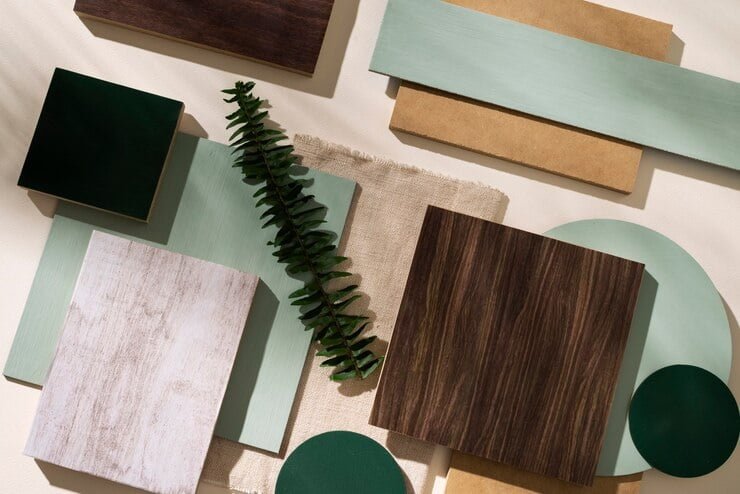When remodeling or building a new home, one of the most important design decisions is choosing the right flooring. The flooring sets the tone for the whole space, impacting both aesthetics and functionality. More than ever before, homeowners and designers are looking for flooring options that are environmentally sustainable as well as beautiful and durable.
Opting for an eco-friendly floor can reduce your carbon footprint, promote healthy indoor air quality, and look fantastic. Here is an in-depth guide to the top sustainable flooring options to consider for your next project.
Why Choose Sustainable Flooring?
Before diving into the specific materials, let’s look at the reasons to choose eco-friendly flooring in the first place:
Promotes Sustainable Forestry and Agriculture
Many green flooring options like bamboo and cork come from rapidly renewable resources. Choosing these materials encourages responsible forest management and agricultural practices.
Reduces Dependence on Non-Renewable Resources
Conventional flooring often depends on materials like vinyl and carpeting derived from petroleum. Eco-flooring increases the use of renewable materials.
Contributes to Healthier Indoor Air Quality
Sustainable flooring options like solid wood and natural linoleum emit fewer VOCs (volatile organic compounds). This creates a healthier home, especially for those with allergies or chemical sensitivities.
Longer Lifespan & Easy to Repair
Quality sustainable flooring lasts for decades with proper care. Materials like stone and cork are also easy to repair and replace partially when needed.
Biodegradable & Recyclable
At the end of its lifespan, green flooring like bamboo and linoleum can be recycled or safely returned to the earth. This reduces landfill waste.
Stunning Natural Beauty
In addition to their eco-benefits, many green floors like slate and reclaimed wood offer unparalleled natural elegance and visual interest.
Supports Local Economies
Purchasing locally-produced sustainable flooring keeps money in local communities. This strengthens regional economies.
Now that you know the many benefits of eco-flooring, let’s explore the top green options on the market today.
Top Sustainable Flooring Options
1. Bamboo Flooring
Bamboo has emerged as one of the superstars of eco-flooring. This renewable grass can be harvested every 3-5 years without needing to replant. Bamboo matures rapidly, achieving its full height within just 4-6 months of sprouting.
Benefits:
- Extremely renewable & sustainable resource
- Grows rapidly without pesticides or fertilizers
- Beautiful natural grain patterns
- Durable and scratch-resistant
- Stabilizes indoor humidity & resists mold
- Available in planks, like hardwood
Considerations:
- Production uses adhesives (look for low-VOC)
- Can dent or scratch over time
- Color fades from UV exposure if unfinished
Overall, bamboo is an excellent choice for an eco-friendly floor that rivals hardwoods in beauty and durability. Opt for low-VOC adhesives and penetrating oil finishes to enhance sustainability. FSC-certified bamboo supports responsible sourcing.
2. Cork Flooring
Derived from the bark of cork oak trees, cork flooring provides natural sound absorption and comfort underfoot. The bark is harvested without harming the trees, which live for over 200 years.
Benefits:
- Renewable & recyclable resource
- Naturally moisture and mold-resistant
- Excellent acoustic and thermal insulation
- Comfortable and quiet underfoot
- Naturally fire and insect resistant
- Easy to install and maintain
Considerations:
- Show wear over time if not properly sealed
- Can stain if not properly maintained
- Limited color/style options
Cork offers an attractive, comfortable, and easy-care sustainable flooring option. Use polyurethane finishes to protect against wear, regular cleaning, and occasional resealing. FSC-certification ensures responsible harvesting.
3. Natural Linoleum Flooring
Made from renewable materials like linseed oil, cork dust, wood flour, and pine resin, natural linoleum has been around for over 150 years. It offers an attractive, durable, and biodegradable alternative to vinyl flooring.
Benefits:
- Made from abundant natural materials
- Naturally antibacterial and antimicrobial
- Does not emit harmful VOCs
- Long lifespan of 30-40 years
- Naturally fire-resistant
- Easy to clean and maintain
- Can be recycled at end of life
Considerations:
- Avoid low-quality linoleum
- Seams are more visible than with vinyl
- Can stain, fade without proper finish
With proper installation and polyurethane finishing, linoleum makes an excellent green flooring choice. It’s important to avoid inferior quality linoleum, as the name is not regulated. Seek floors marked as natural linoleum.
4. Solid or Engineered Sustainable Hardwood
Traditional hardwood floors remain a sought-after flooring choice prized for durability and timeless beauty. When sourced sustainably from responsibly managed forests, hardwoods can also be an eco-friendly option. Opt for FSC-certified woods.
Benefits:
- Durable for decades with care
- Timeless beauty and value
- Cozy and comfortable underfoot
- Can be refinished instead of replaced
- Responsible forestry aids ecosystem
Considerations:
- Not as eco-friendly as faster-growing options
- Still dependent on wood logging
- Susceptible to scratches and dents
- Moisture can damage solid hardwood
Using reclaimed hardwood offers an even more sustainable choice. Reclaimed wood is salvaged from old buildings, barns, and demolition sites. This prevents usable lumber from ending up in landfills.
5. Natural Stone Flooring
Slate, granite, travertine, and marble floors have graced palaces and temples for millennia thanks to their ecological benefits and enduring elegance.
Benefits:
- Completely natural product
- Responsibly sourced from quarries
- Extremely durable and long-lasting
- Easy to clean and maintain
- Cooling effect helps regulate temperature
- Unique veining patterns in each piece
Considerations:
- Heavy and requires reinforced subfloor
- Can be cold underfoot unless heated
- Resealing required to prevent stains
- Scratches and chips can occur over time
For a floor that can literally last centuries with proper care, natural stone is hard to beat. Just take the weight and installation considerations into account before purchasing.
6. Recycled Rubber Flooring
Most rubber flooring today is made through recycling old tires and other rubber waste that would otherwise end up in landfills. This innovative flooring diverts waste while offering practical benefits.
Benefits:
- Made from recycled rubber waste
- Extremely durable and slip-resistant
- Excellent shock absorption & noise reduction
- Easy to clean and maintain
- Resists stains, mold, mildew & bacteria
- Ideal for basements, playrooms, gyms
Considerations:
- Limited aesthetics/color options
- Can fade or discolor over time
- Seams are noticeable
- Offgassing possible initially
For areas where durability and water-resistance are priorities, recycled rubber makes an excellent choice. Seek products made from 90%+ recycled materials. Limit use to non-living areas due to offgassing.
7. Recycled Glass Tiles
Turning used glass bottles and fixtures into beautiful floor tiles is yet another innovative recycled material. The tiles contain about 70% recycled glass.
Benefits:
- Made from recycled bottles/glass
- Extremely durable and stain resistant
- Easy to clean and disinfect
- Resists water, mold, and mildew
- Eye-catching and shimmery appearance
- Available in range of colors
Considerations:
- Grout lines prone to staining
- Hard underfoot for extended standing
- Not ideal for cushion or warmth
- Can crack or chip if heavy loads dropped
For kitchens, bathrooms, and light-use commercial spaces, recycled glass tiles offer an easy-maintenance sustainable option. Use dark grout lines to limit staining appearance. Consider wall applications instead of floors for softer surfaces.
What to Look for in Green Flooring
Now that you’re familiar with the top eco-friendly flooring options, here are a few things to keep in mind when evaluating products:
- Made from renewable resources – Seek floors made from rapidly renewable materials like bamboo or cork over slow-growth woods.
- Responsible sourcing – Look for FSC-certified wood floors or stone quarried under safe conditions.
- Recycled content – Choose materials like recycled rubber or glass that reuse waste.
- Low or no VOCs – Many sustainable floors emit minimal to zero VOCs, improving indoor air quality.
- Locally produced – Support local economies by choosing floors made regionally when possible.
- Non-toxic adhesives – With products like bamboo, verify adhesives used are low-VOC or VOC-free.
- Finishes – Use zero or low-VOC stains, sealers, and finishes to enhance sustainability.
- Long lifespan – Opt for durable floors that will last decades, avoiding the resource costs of frequent replacement.
- Reparability – Choose floors that can be spot repaired and refinished rather than fully replaced.
- Biodegradable – At the end of their lifespan, materials like linoleum and cork can biodegrade rather than sit in landfills.
Installing & Caring for Eco-Floors
Once you’ve selected the ideal green flooring for your home or business, it’s important to install and care for it properly to maximize durability. Here are some tips:
Hire a qualified installer – Eco-flooring often has specific installation requirements. Hire an installer experienced with your chosen material.
Seal and finish floors – Use low-VOC sealers and finishes to protect floors from wear, stains, and moisture. Reapply as needed.
Clean gently – Sweep regularly and clean floors gently with mild, non-toxic cleaners instead of harsh chemicals.
Protect from scratches – Use felt pads under furniture legs and avoid abrasive cleaners or tools.
Check for water damage – Address any moisture issues like leaks immediately to avoid warping or mold growth.
Consider area rugs – Place natural fiber area rugs in high-traffic zones to prevent wear and tear.
Refresh floor periodically – Sand and refinish hardwood floors as needed. Reseal softer floors occasionally.
With proper installation, care, and maintenance, sustainable flooring can last beautifully for decades in both homes and businesses.
Where Should You Use Sustainable Flooring?
Thanks to advancements in materials and manufacturing, eco-friendly floors now come in endless options suitable for nearly any space. Here are some top locations to use green flooring:
- Kitchens – Natural linoleum, cork, or recycled glass tiles make excellent water-resistant options for kitchens.
- Bathrooms – Use stone tile, bamboo, or recycled glass for bathrooms to resist moisture.
- Bedrooms – Opt for quiet, comfortable floors like carpet, cork, or bamboo in bedrooms.
- Living Rooms – Hardwood, bamboo, and natural linoleum work well for durable yet cozy living room floors.
- Basements & Laundry Rooms – Concrete, recycled rubber, or tile are ideal for basements vulnerable to moisture.
- Offices & Commercial Spaces – Cork, recycled rubber, and low-VOC carpets nicely dampen sound in offices.
- Outdoors – Use stone, tile, or composite decking outside for weather-resistant performance.
Nearly any area of your home or business can benefit from the beauty, quality, and sustainability of eco-friendly flooring.
Make the Green Flooring Decision That’s Right for You
As you can see, you have endless options when it comes to selecting an eco-friendly floor. Consider your lifestyle, traffic patterns, maintenance capabilities, and style preferences as you narrow it down. Consulting with knowledgeable flooring professionals at showrooms can help guide your decision.
The most important thing is choosing quality sustainable flooring that excites you both aesthetically and environmentally. With the proper selection, installation, and care, you can enjoy beautiful, responsible floors for decades to come.
Remember to keep factors like offgassing, VOCs, and adhesives in mind as you evaluate products. Certifications like FSC, FloorScore, and Greenguard can help verify sustainability claims. Investing in eco-flooring supports healthy forests and agriculture, reduces waste, and creates toxin-free indoor spaces.
Tell us, which sustainable flooring option intrigues you the most? Are you considering green flooring for an upcoming project? We’d love to hear your thoughts on eco-friendly floors!




No Comment! Be the first one.